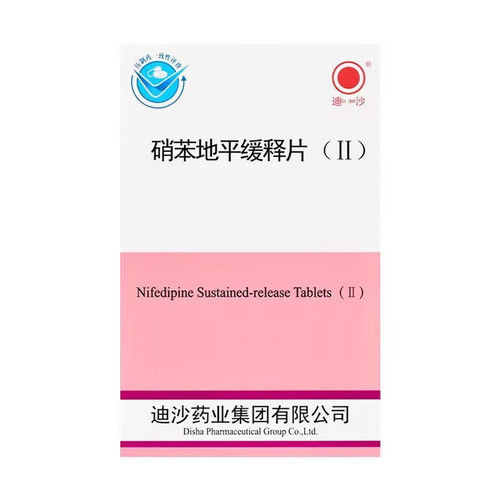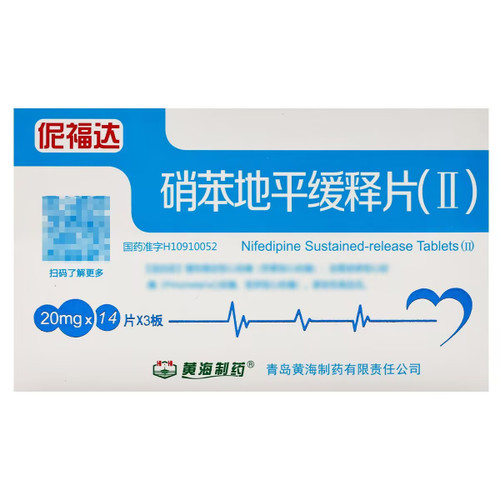Product Overview
[Drug Name]
Generic Name: Nifedipine Sustained-Release Tablets (II)
Trade Name: Bichangtong Nifedipine Sustained-Release Tablets (II) 20mg*40 Tablets
Pinyin Code: BiChangTong XiaoBenDiPingHuanShiPian(II) 20mg*20 Tablets*2Ban
[Main Ingredient]
The main ingredient of this product is nifedipine. Its chemical name is: 2,6-dimethyl-4-(2-nitrophenyl)-1,4-dihydro-3,5-pyridinedicarboxylic acid dimethyl ester. Molecular Formula: C₁₇H₁₈N₂O₆. Molecular Weight: 346.34
[Properties]
This product is a yellow tablet.
[Indications/Main Functions]
-Chronic stable angina (exertional angina); -Vasospastic angina (Prinzmetal's angina, variant angina); -Essential hypertension
Specifications]
20mg*40 tablets
[Dosage and Administration]
Please take this product as prescribed by your doctor. Otherwise, optimal therapeutic effect may be difficult to achieve. Dosage should be individualized based on the severity of the disease and the patient's response to the drug. A standardized dosing regimen should be established gradually based on the patient's clinical symptoms. Patients with impaired liver function should have their liver function closely monitored and the dose reduced. Patients with severe cerebrovascular disease should receive a lower dose. Unless otherwise prescribed, the recommended dosage of this product is as follows: Adults: For chronic stable angina (exertional angina), the standard dose is one tablet twice daily (equivalent to a daily dose of nifedipine 40 mg). Adults: For vasospastic angina (Prinzmetal's angina, variant angina), the standard dose is one tablet twice daily (equivalent to a daily dose of nifedipine 40 mg). The standard dose is 20 mg twice daily; the dose can be increased to 40 mg twice daily. Adults: For essential hypertension, the standard dose is one tablet twice daily (equivalent to a daily dose of nifedipine 40 mg). The standard dose is 20 mg twice daily; the dose can be increased to 40 mg twice daily. Administration: This product should be taken whole with water after meals. Taking it with food may delay, but not reduce, the absorption of this product. The interval between doses should be at least 4 hours. This drug should be discontinued gradually, especially at higher doses.
[Adverse Reactions]
The following symptoms are common, especially at the beginning of treatment, but are usually transient: headache, flushing of the face and/or skin accompanied by a feeling of warmth (erythema), and redness, swelling, and pain in the arms and legs (erythema limbis). Rarely, there may be a rapid pulse (tachycardia), palpitations, and lower extremity edema due to vasodilation. Dizziness and fatigue are rare. Numbness and tingling in the arms and legs and a drop in blood pressure below normal (hypotension) have also been reported. Gastrointestinal disturbances (such as nausea, abdominal distension, and diarrhea) are rare. Skin allergic reactions (such as itching, hives, and rash) are rare. Rare abnormalities in blood counts (such as decreased red blood cell, white blood cell, and platelet counts, and skin and mucous membrane bleeding due to thrombocytopenia) are rare. Gingival hyperplasia has rarely occurred in patients receiving long-term treatment and resolves spontaneously upon discontinuation of the drug. Very rare cases of liver dysfunction (intrahepatic cholestasis, elevated transaminases), low blood counts (agranulocytosis), petechial hemorrhages (purpura) on the skin and mucous membranes, exfoliative dermatitis, photodermatitis, and acute systemic allergic reactions (e.g., swelling of the skin and mucous membranes, laryngeal edema, bronchomus spasm, including fatal respiratory distress) have been reported. These reactions resolve after discontinuation of treatment. Breast swelling (gynecomastia) has rarely occurred, particularly in elderly men treated with this drug for a long time. This symptom resolves spontaneously after discontinuation of treatment. Rare cases of elevated blood sugar have been reported, typically in patients with diabetes. Muscle pain, finger tremors, and mild, transient visual changes have occasionally occurred in patients taking high doses. Rarely, patients have experienced brief loss of consciousness (syncope) due to a decrease in blood pressure at the beginning of treatment. At the beginning of treatment, patients have rarely experienced angina attacks; the frequency, duration, and severity of these attacks may be increased in patients with a history of angina. Patients with impaired renal function may experience transient worsening of renal function during treatment with this drug. Particular attention should be paid to dialysis patients with hypertension and hypovolemia, as vasodilation may result in a significant decrease in blood pressure. Urine output may increase during the first week of treatment. If any adverse reactions not described in this package insert are observed during treatment, consult a physician immediately.
[Contraindications]
- Hypersensitivity to nifedipine or other ingredients in this product. - Previous cardiogenic shock. - Severe aortic stenosis (stenosis of the aorta). - Unstable angina. - Recent myocardial infarction (within the past 4 weeks). - Patients currently taking rifampin. - Pregnant women.
[Precautions]
Patients with severe hypotension (systolic blood pressure below 90 mmHg) or decompensated heart failure should only take this product after consulting a physician and under special monitoring. This applies even if the patient has only experienced these conditions in the past. Although nifedipine-induced hypotension in patients with angina is generally moderate and tolerable, it can occasionally result in an excessive drop in blood pressure that the patient cannot tolerate. This phenomenon often occurs during medication initiation, dose increases, and concomitant use of beta-blockers. There have been reports of severe hypotension and/or the need for volume expansion in patients receiving concomitant nifedipine and beta-blockers undergoing coronary artery bypass surgery when high-dose fentanyl is administered. This drug interaction may occur with the combined use of nifedipine and beta-blockers, as well as with nifedipine alone, low-dose fentanyl, other surgical procedures, or anesthetics. Physicians should be aware of this issue when high-dose fentanyl is administered to patients receiving nifedipine. If possible, nifedipine should be washed out before surgery (at least 36 hours). Patients receiving nifedipine for hypertension and/or angina may experience increased angina and/or myocardial infarction. Rarely, the frequency, duration, and/or severity of these episodes may be increased during medication initiation and/or dose increases, particularly in patients with severe occlusive coronary artery disease. However, the mechanism is unclear. Gradually reducing the dose of beta-blockers is preferable to abruptly stopping beta-blockers before starting nifedipine. Patients who have recently stopped beta-blockers may experience a withdrawal syndrome with increased angina, possibly related to increased catecholamine sensitivity. Rarely, heart failure may develop after starting nifedipine in patients receiving beta-blocker therapy, with patients with aortic stenosis at greater risk. Because nifedipine breakdown is delayed in patients with hepatic insufficiency, physicians should closely monitor the course of nifedipine. If necessary, the dose should be reduced. A lower dose should be used in patients with severe cerebral circulation (cerebrovascular disease). Dialysis patients with malignant hypertension and hypovolemia should be aware of the potential for significant decreases in blood pressure due to vasodilation. Due to individual responsiveness, this medication may affect the ability of individuals who drive vehicles, operate machinery, or otherwise engage in activities without appropriate safety precautions. This effect may occur primarily during the initial treatment phase, during dose increases, during medication changes, or during concomitant alcohol consumption. Therefore, patients in these occupations require regular clinical follow-up while receiving this medication. If the dose of this product is too low or a dose is missed, do not take a double dose of this product at one time. Take the next normal dose according to the dosing interval specified in the prescription.






